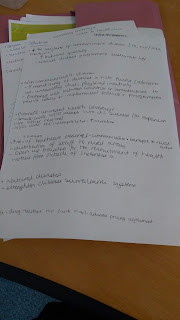I produced a pack for the event to help remind me what the procedure was and to remember all of the facts, figures, solution and challenges I was trying to present for the country I was representing. This post details what I included in my pack and how I prepared for the event.
1. Resources provided by the event
I found the resources provided by the event a little overwhelming so I printed them all of, highlighted everything I didn't understand (there was a lot of highlighting required!) and wrote notes everywhere. Mostly my notes consisted of writing the definitions for all the different words I hadn't heard of before because they were in a separate section and it was annoying flicking backwards and forwards. I also added a title on the top of all of them so I knew which guide to grab if I wanted to review my knowledge.
This section also included a list of all the regions because I wasn't certain on them.

2. Resources specific to my country
- United Nations (2016), Protecting humanity from future health crises, Report of the High-level Panel on the Global Response to Health Crisis - I printed Chapter II National level and Chapter III Regional and subregional levels to have an indication and some examples of possible solutions to health challenges
- Pezzini, M. (2017), Opportunities and Challenges in Southeast Asia, China and India - I printed and highlighted this article on what the biggest challenges are for the region my country was in
- WHO (n.d.), Country Profiles: Indonesia - I thought this was a really helpful factsheet for data on health in Indonesia, which can be read in a glance.
- WHO (2014), Noncommunicable Diseases Country Profiles - Another useful factsheet for data on health in Indonesia, which can be read in a glance, this time with a focus on NCDs.
- WHO (n.d.), Country Profiles: Indonesia - Another useful factsheet for data on health in Indonesia, which can be read in a glance, this time with a focus on tuberculosis.
- CIA (2018), The World Factbook, Indonesia - A very useful and total source of facts. I printed it all and highlighted the most important facts
- WHO (2017), Addressing inequalities on the road to ‘health for all’ in Indonesia - I went on the WHO webiste and printed (and highlighted) any recent articles about my country
- Wikipedia (2018), Health in Indonesia - I print off the Wikipedia page. There is no shame! It is a good source of basic facts that don't necessarily have to be 100% accurate
- WHO (n.d.), Indonesia - A factsheet about Indonesia. Not as detailed as the CIA one but easy to have a quick look to remember some statistics
- WHO (2016), WHO Country Cooperation Strategy 2014-2019: Indonesia - A long read but very good country-specific data
3. My own notes
My notes consisted of facts and figures (e.g. about the maternal mortality rate, TB, HIV), which can be found in a separate post and my Position Paper that I had printed, highlighted and wrote notes on, which can be found in another separate post . I also added a script for myself to remember what I should say.
4. Spare paper


